What are fungi? How fungi differ from other plants?
Fungi (fungus) in Latin literally means mushrooms. Fungi are eukaryotic organisms with true nucleus and membrane bounded organelles. They are non-vascular Cryptogams included in Thallophyta along with algae due to their undifferentiated plant body. The study of fungi is called mycology and the one who study fungi is called Mycologist. The word in Latin ‘mykes’ means fungus.
Fungi General Characteristics
Ø Kingdom fungi includes about 5100 genera and 50,000 species
Ø Fungi are heterotrophs since they lack chlorophyll
Ø Fungi cannot synthesize their own carbohydrates using, CO2, water and sunlight.
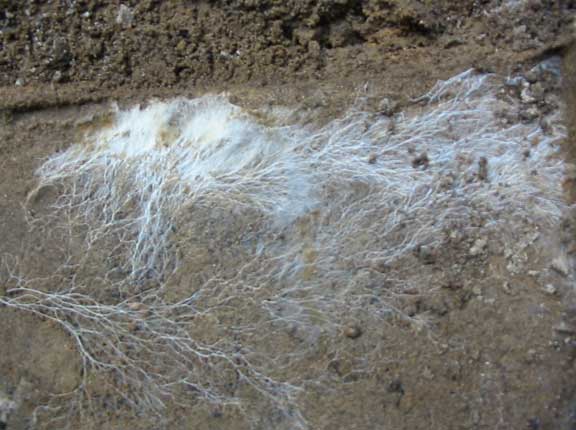
Fungal Mycelium (source wikipedia)
Ø Plant body of fungi consists of thallus make up of hyphae which together constitute the mycelium
Ø Fungi show much diversity in form, structure of plant body and method of reproduction
Ø Fungi are cosmopolitan in distribution, occurs in any habitat where life is possible
Ø Some fungi are aquatic, which may be fresh water or marine
Ø Most of the fungi are terrestrial forms
Ø Many species of fungi are parasite to plants, animals and human
Ø Majority of the diseases of cultivated plants are caused by fungi and thereby they have immense economic importance
What is mycelium and hyphae?
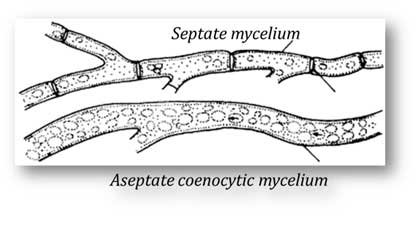 Ø Plant body of fungi typically consists of branched and filamentous hyphae
Ø Plant body of fungi typically consists of branched and filamentous hyphae
Ø Hyphae forms a net like structure called mycelium
Ø Hyphae may be aseptate (without septa) or septate (with septa)
Ø In aseptate forms, the hyphae will be coenocytic (multinucleate condition)
Ø In septate forms, the hyphae may be uninucleate or binucleate or rarely multinucleate
Ø Septa usually have simple pore (hole) at the centre for the cell to cell communication
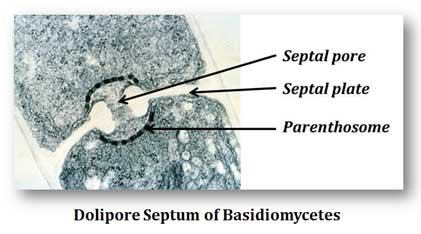 What is dolipore septum?
What is dolipore septum?
Ø In Basidiomycetes (a division of fungi) the septa is highly advanced, here dolipore septa occurs
Ø On both sides of dolipore septum a double membrane structure called septal pore cap or parenthosome occurs
Ø Parenthosomes of dolipore septa act as valves which can regulate the passage of cell contents between cells
How fungal cell wall is different from the cell wall of other plants?
Ø Protoplast of fungi is surrounded by distinct cell wall
Ø In slime molds (lower fungi, closely related to Protistis) the cell wall is absent
Ø Main component of cell wall is chitin (a major difference of fungal cell wall from plant cell wall)
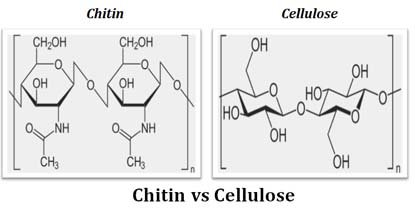 Ø Chitin is a polymer of an N-acetylglucosamine, a derivative of glucose
Ø Chitin is a polymer of an N-acetylglucosamine, a derivative of glucose
Ø In some lower fungi (Oomycetes) cell wall is composed of cellulose and glucan
How mitosis in fungi is different from other eukaryotes?
Ø The nucleus of fungi is very small
Ø Fungi have special type of mitosis called nuclear mitosis
Ø Mitosis in fungi is different from that in other eukaryotes
Ø In fungi, during mitotic cell division, the nuclear envelope does not break down and re-form. Instead, mitosis takes place within the nucleus
Ø Spindle apparatus is formed within the nucleus, which drag the chromosomes to two opposite poles of nucleus (not the cell as in most other eukaryotes)
What is meant by dikaryotization?
Ø Fungal hyphae may be homo-karyotic (only one strain of nuclei) or hetero karyotic (different strains of nuclei)
Ø Hyphae may be haploid, diploid or dikaryotic
Ø Dikaryotic condition is seed in higher fungi only (members of Ascomycetes and Basidiomycetes)
Ø In dikaryotic mycelium, two different strains of nuclei (+ and -) stay separately in the cell and they simultaneously divide when the cell divides
Ø The process of formation of dikaryotic mycelium is called dikaryotization
What are the hyphal modifications in fungi?
Ø In majority of fungi, hyphae are simple
Ø In some advanced fungi, hyphae may undergo certain modification in response to functional needs
Ø Important hyphal modifications in fungi are: Prosenchyma, Pseudoparenchyma, Rhizomorphs, Sclerotia, Appressorium, Haustoria, Stroma and Hyphal traps (snares)
Learn more: Hyphal Modifications in Fungi
What is the type of nutrition in fungi?
Ø Fungi are heterotrophic in nutrition (they do not manufacture food)
Ø Fungi are entirely devoid of chlorophyll, however carotenoids and other colour pigments are present
[table “” not found /]Ø On the basis of made of nutrition, fungi are classified into three groups:
1. Parasites: grow and feed on other living plants or animals (hosts)
2. Saprophytes: grown and feed on dead organic matters
3. Symbionts: mutual association between algae or roots of higher plants (lichens and mycorrhiza are examples)
Learn more: Lichen Characteristics
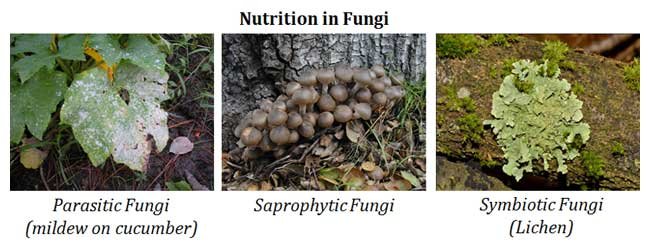
Ø Fungi digest food first and then ingest (absorb) the food into cells, to accomplish this the fungi produce exoenzymes (enzymes which acts outside the cell)
Ø The food reserve of fungi is glycogen (similar to animals cells)
Learn more: Nutrition in Fungi
How fungi reproduce?
Ø Fungi reproduce by vegetative, asexual and sexual methods
Ø Sexual state of fungi is called teleomorph
Ø Asexual state of fungi is called anamorph
Ø Vegetative reproduction in fungi takes place by Fragmentation (Eg. Rhizopus, Aspergillus), Fission (Eg. Yeast) and Budding (Eg. Yeast)
Ø About 20% fungi (mostly members of Deuteromycetes) propagate only by asexual means, they completely lack sexual reproduction
Ø Asexual reproduction takes place during favorable condition by the formation of a variety of conidia or spores
Ø Fungal spores may be unicellular (Aspergillus, Penicillium) or multicellular (Alternaria, Cercospora)
Ø Spores may be endogenous when enveloped in pycnidia or sporangia (Mucor, Rhizopus) or they may be exogenous when developed on sporophores or conidiophores (Aspergillus, Penicillium)
Ø Common asexual spores of fungi are: Zoospores, Conidiospores (conidia), Clamydospores and Oidia:
Learn more: Different types of Spores in Fungi
Ø In lower fungi reproductive cells are flagellated and motile
Ø Flagella are of two types in fungi
1. Whiplash (Acronematic): smooth flagella with 9+2 organization
2. Tinsel (Pantonematic): Flagella with numerous minute hair like projections called mastigonemes, originate from the axial filament
Ø Motile reproductive structures are completely absent in higher fungi (Ascomycets, Basidiomycets and Deuteromyces)
Holocarpic vs Eucarpic fungi
Ø In some unicellular forms the whole vegetative cell is transformed to a reproductive unit and such a fungi is called holocarpic fungi
Ø In most fungi only a part of the vegetative mycelium forms the reproductive unit and the rest remain vegetative, such a fungi is called eukarpic fungi
How sexual reproduction occurs in fungi?
Ø Sexual reproduction takes place in all group of fungi except Deuteromycetes (fungi imperfectii)
Ø Fungi may be monoecious (bisexual) or dioecious (unisexual)
Ø Moneoecious species produce the two types of sex organs (male and female) in the same thallus, and hence they are called homothallic forms
Ø Dioecious forms produces male and female sex organs in separate thalli, hence called heterothallic forms
Ø The process of sexual reproduction is completed in three distinct phases
1. Plasmogamy: fusion of cytoplasm
2. Karyogamy: fusion of nucleus
3. Meiosis: reduction division
Ø In higher groups of fungi, plasmogamy do not immediately follows kaaryogamy, the cell will hold the two nuclei separately in order to establish dikaryotization
Ø In sexual reproduction the two compatible nuclei (male and female) are brought together by any of the following processes:
1. Planogametic copulation: fusion of two motile gametes by isogamy, anisogamy or oogamy
2. Gametangial contact: male and female gametangia connect each other by fertilization tube
3. Gametangial copulatin: entire content of two gametangia fuse together
4. Spermatization: fusion of minute spores called spermatia and specialized receptive hyphate acting as male and female structures respectively
5. Somatogamy: sex organs not formed, two vegetative cells fuse together, highly advanced type
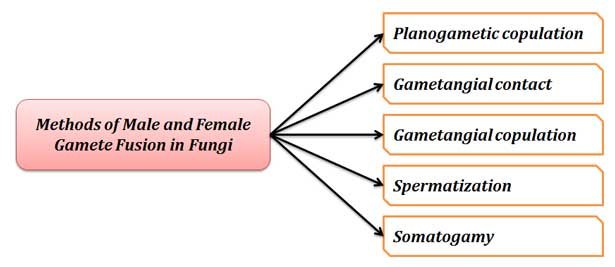
Ø Fungi exhibit the phenomenon of alteration of generation
Ø Fungi have immense economic importance to man

thank you
good
It’s outstanding
Very Nice !!!
Excellent
Thank you
Its best
Thank you